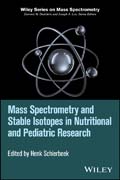
Mass Spectrometry and Stable Isotopes in Nutritional and Pediatric Research
Schierbeek, Henk
A guide for scientists, pediatricians and students involved in metabolic studies in pediatric research Addresses the availability of modern analytical techniques and how to apply these techniques in metabolic studies Covers the whole range of available mass spectrometric techniques used for metabolic studies including Stable Isotope Methodology Presents the relevance of mass spectrometry and stable isotope methodology in pediatric research covering applications in Nutrition, Obesity, Metabolic Disorders, and Kidney Disorders Focuses on the interactions between nutrients and the endogenous metabolism within the body and how these factors affect the health of a growing infant INDICE: List of Contributors xvii .Introduction xxi .List of Abbreviations xxiii .1 Mass Spectrometry Techniques for In Vivo Stable Isotope Approaches 1Jean–Philippe Godin and Henk Schierbeek .1.1 Introduction 1 .1.2 Nomenclature for Light–Stable Isotope Changes 3 .1.3 Mass Spectrometry Techniques 6 .1.4 Choice of Mass Spectrometric Techniques and Applications to Measure Isotopic Enrichments in Metabolic Studies 26 .1.5 Conclusion and Future Perspectives 30 .References 32 .2 Stable Isotope Technology 45Dewi van Harskamp, Johannes B. van Goudoever, and Henk Schierbeek .2.1 History 45 .2.2 Definition 45 .2.3 Safety 46 .2.4 Stable Isotopes and Natural Abundances 47 .2.5 Stable Isotope Selection 48 .2.6 Single or Multiple Label Selection 49 .2.7 Precursor Model 49 .2.8 Simultaneous Infusion 49 .2.9 Infusion Techniques 50 .2.10 Steady State 52 .2.11 Pool Selection 52 .2.12 Pool Models 53 .2.13 Flux: Synthesis and Breakdown 55 .2.14 Nitrogen Balance 57 .2.15 Doubly LabeledWater Method 57 .2.16 Whole–body Protein Synthesis 58 .2.17 Specific Protein Synthesis 58 .2.18 Calculations 59 .2.19 Considerations and Drawbacks of Isotopic Tracers 62 .2.20 Conclusion 63 .References 63 .3 Stable Isotopes in Nutritional and Pediatric Research 67Willemijn E. Corpeleijn and Johannes B. van Goudoever .3.1 Introduction 67 .3.2 Ethical Aspects 69 .3.3 Applications of Stable Isotopes in Nutritional and Pediatric Research 70 .3.4 Conclusion 78 .References 78 .4 Early–Life Nutrition and Stable Isotope Techniques 81Stefanie M.P. Kouwenhoven and Marita deWaard .4.1 Introduction 81 .4.2 Breast Milk versus Infant Formula 81 .4.3 Techniques to Monitor Milk Intake 82 .4.4 Body Composition in Term and Preterm Infants 86 .4.5 Amino Acid Requirement 86 .4.6 Clinical Applications 87 .4.7 Additional Applications 95 .4.8 Discussion 98 .4.9 Conclusion 99 .4.10 Future Perspectives 99 .References 100 .5 Assessment of Amino Acid Requirement in Children Using Stable Isotopes 108Femke Maingay–de Groof and Henk Schierbeek .5.1 Introduction 108 .5.2 Nutrient Needs and Definitions 109 .5.3 Methods to Determine Requirements 111 .5.4 Isotopic Tracer Methods 112 .5.5 Existing Methods to Determine Amino Acid Requirement for Neonates 114 .5.6 Use of the IAAO Method in the Pediatric Population 115 .5.7 Necessity for Performing the Study 117 .5.8 Biochemistry 117 .5.9 Available AnalyticalMethods 120 .5.10 Clinical Application 120 .5.11 Analysis and Calculations 125 .5.12 Results 125 .5.13 Statistical Analysis 128 .5.14 Discussion 129 .5.15 Conclusion 131 .5.16 Future Perspectives 132 .References 132 .6 Metabolism of Glutamine, Citrulline, and Arginine; Stable Isotopes Analyzing the Intestinal Renal Axis 139Nikki Buijs, Saskia J.H. Brinkmann, Gerdien C. Ligthart–Melis, and Henk Schierbeek .6.1 Introduction 139 .6.2 Biochemistry 142 .6.3 Isotopic Model 146 .6.4 Study Design 148 .6.5 Mass Spectrometry Methods 151 .6.6 Clinical Applications 155 .6.7 Calculations 158 .6.8 Discussion and Future Perspectives 161 .References 167 .7 Applications in Fat Absorption andMetabolism 175Dirk–Jan Reijngoud and Henkjan J. Verkade .7.1 Introduction 175 .7.2 Biochemistry of Fat Absorption 176 .7.3 Isotope Model 178 .7.4 Study Design/Infusion Protocols 179 .7.5 Analytical Equipment 181 .7.6 Analytical Conditions 181 .7.7 Accuracy and Precision 183 .7.8 Calculations 184 .7.9 Clinical Applications 187 .7.10 Future Perspectives 191 .References 193 .8 Materno–Fetal Lipid Kinetics 197Elvira Larqué, Hans Demmelmair, and Berthold Koletzko .8.1 Introduction 197 .8.2 Biochemistry of Placental Lipid Transport 198 .8.3 Investigation of Fatty Acid Metabolism Using Stable Isotopes 200 .8.4 Mass Spectrometry Methods 202 .8.5 Clinical Studies with Fatty Acids Labeled with Stable Isotopes in Healthy and Complicated Pregnancies 203 .8.6 Calculations 207 .8.7 Future Perspectives 209 .Acknowledgments 210 .References 210 .9 Stable Isotope Applications in Human In Vivo Placental and Fetal Research 213Chris H.P. van den Akker .9.1 Introduction 213 .9.2 Investigation of FetalMetabolism Using Stable Isotopes 214 .9.3 Study Designs and Models 215 .9.4 Infusion Protocols and Clinical Applications 216 .9.5 Necessary Additional Clinical Parameters to be Analyzed 218 .9.6 Necessary Analytical Mass–Spectrometry Equipment and Analytical Conditions 218 .9.7 Calculations 219 .9.8 Future Perspectives 222 .References 222 .10 Obesity 225Margriet Veldhorst and Henk Schierbeek .10.1 Introduction 225 .10.2 Singly and Doubly LabeledWater 226 .10.3 Substrate Oxidation 237 .10.4 Glucose Metabolism 238 .10.5 Fat Metabolism 239 .10.6 Protein Turnover 242 .10.7 Calculations 246 .10.8 Discussion and Future Perspectives 249 .References 250 .11 Inborn Errors of Metabolism 258Hidde H. Huidekoper, Frits A.Wijburg, and Ronald J.A.Wanders .11.1 Introduction 258 .11.2 Stable Isotope Techniques 260 .11.3 Analytical Equipment and Methods 267 .11.4 Study Protocol: Quantifying Endogenous Galactose Production 269 .11.5 Calculations 271 .11.6 Discussion 276 .11.7 Future Perspectives 277 .References 278 .12 Renal Disease and Dialysis 284Gregorio P.Milani, Sander F. Garrelfs, and Michiel J.S. Oosterveld .12.1 Introduction 284 .12.2 Total BodyWater and Its Distribution 286 .12.3 Protein Metabolism in Chronic Kidney Disease 291 .12.4 Dialysis Metabolic Consequences and Nutrient Losses 293 .12.5 Primary Hyperoxalurias 295 .12.6 Clinical Applications 298 .12.7 Calculations 303 .12.8 Discussion 308 .12.9 Future Perspectives 310 .References 310 .13 Application in Oxidative Stress and Glutathione Metabolism in Preterm Infants 320Denise Rook and Henk Schierbeek .13.1 Introduction 320 .13.2 Biochemistry/Model 321 .13.3 Guidelines and Safety Procedures 323 .13.4 Mass Spectrometry Methods 323 .13.5 Materials and Methods 324 .13.6 Clinical Application (A Practical Example of a Study Protocol) 327 .13.7 Calculations 329 .13.8 Discussion and Future Perspectives 330 .References 331 .14 Nutrient Digestion and Absorption During Intestinal Malfunction and Diseases 336Margot Fijlstra .14.1 Introduction 336 .14.2 Clinical Application 340 .References 357 .Index 365
- ISBN: 978-1-118-85877-6
- Editorial: Wiley–Blackwell
- Encuadernacion: Cartoné
- Páginas: 416
- Fecha Publicación: 24/03/2017
- Nº Volúmenes: 1
- Idioma: Inglés
